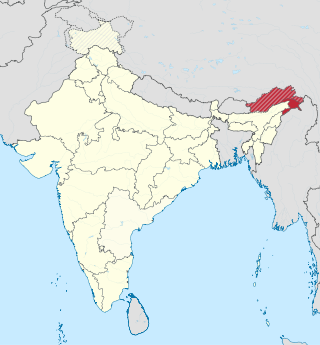| Kho-Bwa | ||
|---|---|---|
| Región | Arunachal Pradesh (Himalaya oriental) | |
| Países |
| |
| Hablantes | ≈15 000 (2005) | |
| Familia | L. kho-bwa | |
 Arunachal Pradesh (India)
| ||
Las lenguas kho-bwa (también llamadas lenguas sherdukpen-bugun-sulung-lishpa, bugúnico o kaméngico) son un pequeño grupo de lenguas tibetano-birmanas habladas en Arunachal Pradesh, en el noreste de India. El grupo completo tiene unos 15 hablantes si se incluye el puroik (10 000 si no se incluye) de acuerdo a las estimaciones durante la década de 2000.
El término kho-bwa fue propuesto por Van Driem (2001), basándose en las formas léxicas *kho 'fuego' y *bwa 'agua'. Blench (2011) sugirió usar mejor el término kaméngico, basado en el nombre de la región de Kameng en Arunachal Pradesh, o alternativamente bugun–mey, a partir de los nombres de las dos lenguas principales. Mastioff había usado el término sherdukpen-bugun-sulung-lishpa, a partir de los nombres de varias de las lenguas del grupo.
Tanto Van Driem como Blench consideran que tanto el <i>bugun</i> (o <i>khowa</i>), como el <i>mey</i> (o <i>sherdukpen</i>) y el <i>lishpa</i> (o <i>lish</i>) forman claramente parte del mismo grupo filogenético. Sin embargo el <i>puroik</i> (o <i>Sulung</i>) solo es considerado como parte del grupo por Van Driem, mientras que Blench lo trata como lengua aparte no directamente relacionada con el grupo kaméngico.
Clasificación
Estas lenguas han sido colocadas tradicionalmente dentro de las lenguas tibetano-birmanas pero su justificación como grupo filogenético ha sido discutida. Todas las lenguas de este grupo han sido fuertemente influidas por las lenguas tibetano-biermanas vecinas, pero eso no implica necesariamente una unidad filogenética y las similitudes podrían deberse a un efecto de sprachbund.[1]
La clasificación interna a partir de las propuestas de Van Driem y Blench es:
Comparación léxica
Los numerales en diferentes lenguas kho-bwa son:[8]
GLOSA Bugun
(Khowa)Sherdukpen
(Mey)Sulung
(puroik)PROTO-
KHO-BWA'1' jo han ɦui33 '2' nyeng nyit ȵi33 *ŋit '3' um ung ɣɯək33 *ɣ-um(?) '4' wi phsi vəʴi33 *w-ɬi(?) '5' kua khu wu33 *ŋwa(?) '6' rap chuk ɣək33 *truk(?) '7' millie sit liɛ33 *slit(?) '8' mla sargyat lɑ33 *-r-gyat(?) '9' dige thikhi dɔŋ33 ɡɛʴ53 *di-gi '10' sũa sõ suat53 paʴ53 *sũat(?)
Referencias
- ↑ Blench (2011): "Certainly, the phonology and morphology of Arunachali languages looks superficially like Tibeto-Burman, which explains their placing in the Linguistic Survey of India. Unfortunately, this is rather where matters have remained [... this paper] proposes we should take seriously the underlying presumption probably implied in Konow’s statement in Linguistic Survey of India. Volume III, 1, Tibeto-Burman family, Calcutta (1909:572)], that these languages may not be Sino-Tibetan but simply have been influenced by it; that they are language isolates."
- ↑ bgg at SIL Ethnologue
- ↑ sdp at SIL Ethnologue
- ↑ onp at SIL Ethnologue
- ↑ lsh at SIL Ethnologue
- ↑ cvg at SIL Ethnologue
- ↑ suv at SIL Ethnologue
- ↑ Sino-Tibetan Numerals (E. Chan) Archivado el 5 de marzo de 2012 en Wayback Machine.
Bibliografía
- George van Driem (2001) Languages of the Himalayas: An Ethnolinguistic Handbook of the Greater Himalayan Region. Brill.
- Blench, Roger. 2011. (De)classifying Arunachal languages: Reconsidering the evidence
